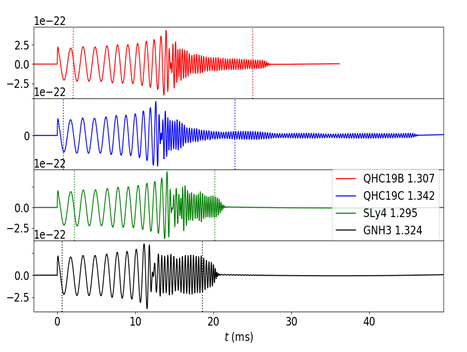Binary neutron star mergers
*These higher quality movies are streaming from a Google Drive. If they don't play, try logging into a Google account and/or use Chrome, or see the second (non-Gdrive) page. The information is identical on both these pages.
Mergers of a pair of neutron stars for different equations of state (EoS) starting from a single polytropic (first simulation) to Quark-Hadron Crossover EoS from Baym et al. (2019). Simulations performed by forming initial data using LORENE and evolution using Einstein Toolkit.
Plot specifications: Timescale is in "Cactus Units", where 1000 CU ≈ 5 milliseconds. The axes are normalized such that units 20 units ≈ 30kms.
Notice QHC 19B (above) and 19C (below) undergo significantly different evolution histories. For EoS = 19B, the hypermassive neutron star collapses to being a black hole very quickly in comparison to 19C, which persists for much longer.


Parfiles for this work can be found at:
bns19b_m_1.45
bns19b_m_1.50
bns19b_m_1.55
bns19c_m_1.45
bns19c_m_1.50
bns19c_m_1.55
bnsgnh3_m_1.48
bnssly_m_1.48
bnssly_m_1.55
References:
[2] AK, H.I. Kim, I.-S. Suh, G.J. Mathews, Binary neutron star mergers as a probe of quark-hadron crossover equations of state, Phys. Rev. D 106, 103027 (2022).
[3] S.R. Brandt, B. Brendal*, W. E. Gabella*, R. Haas*, B. Karakas*, AK*, S.G. Rosofsky*, A.P. Schaffarczyk*, et al. (2020, May 30). The Einstein Toolkit (Version The "Turing" release, ET_2020_05). (*=co-second authors)
Einstein Toolkit contributions
The Einstein Toolkit is an international community-driven software platform of core computational tools to advance and support research in relativistic astrophysics and gravitational physics. As an active member of the Einstein Toolkit community, I perform tests on the binary black hole and the binary neutron star gallery examples.LORENE contributions
Additionally, I have summarized the framework and workflow for construction of binary neutron star initial data using LORENE in a few different documents available below.PhD Thesis
Google doc
A tutorial video from 2021 North American Einstein Toolkit meeting.